Giant or Blackening Polypore / Summer/ Autumn / Edible
Step into the realm of awe-inspiring culinary treasures as we embark on an exploration of the edible Giant Polypore Mushroom (Meripilus giganteus).
Join us on a journey where gastronomy meets magnificence. With its impressive size and distinctive fan-like structure, the Giant Polypore Mushroom commands attention as a remarkable edible delight. Discover the key features that make it easily identifiable, explore its preferred habitats, and delve into the culinary wonders it holds.
From its meaty texture to its robust flavour profile, this mushroom possesses the ability to elevate your culinary creations to extraordinary heights.
Whether you are an avid forager or an adventurous home cook, let the Giant Polypore Mushroom inspire your culinary endeavours and satiate your palate with its extraordinary flavours. Embrace the bountiful wonders of nature as we celebrate the enchanting delights that lie within the Giant Polypore Mushroom. Get ready to embark on a flavour-filled journey as we explore the captivating culinary possibilities offered by this majestic fungus.
Scientific Name
Meripilus giganteus
Common Name
Blackening Polypore, Black-staining Polypore
Family
Meripilaceae
Habitat
This fungus is common across Europe, Scandinavia and Russia and is also recorded in Turkey and Iran. A similar species, Meripilus Sumstinei, grows in North America.
This fungus grows around the bases or broad-leaved trees such as Beech or Oak, or much more rarely on conifers. It forms clusters on trunks or branches, or sometimes on the ground nearby where it springs up from the roots of the tree. It can keep feeding on dead wood above and below the ground after the tree has died, so you might see it on or near stumps or even appearing to grow straight from the ground – when there is a stump or log just under the ground.
Found in summer and autumn, although some specimens will survive through winter.
Identifying Features
This fungus grows clusters with big rounded fan shaped lobes.
When on the ground it can form rosettes, almost like a big brown cabbage.
Fruit body
The individual lobes or brackets can be 10-30cm across, and 1-3 cm thick, firm but flexible with softly rounded edges.
The colour can vary a lot ranging from creamy buff to brown in colour, typically cream at edges and with bands of lighter and darker brown towards the base of the bracket. They look fairly smooth, but if you look closely you could see small scales. The underside is cream and covered in tiny holes or pores that release cream coloured spores as they mature. The flesh is creamy white, and firm.
The key identifying feature is the way they quickly bruise black when cut or squeezed.
Smell
This isn’t a strong-smelling mushroom. Older specimens can smell slightly sour; younger ones softer and pleasantly mushroomy.
Spores
White
Known hazards
Like with any wild mushroom it is possible to be allergic to it or have some tummy trouble if it is undercooked. To reduce the chances of a bad time try a small amount first if you haven’t had it before, and cook thoroughly.
Learn more here about the fibres in mushrooms
Could Be Confused With
Chicken of the Woods (laetiporus sulphureus) has a similar shape especially when young, but shows much brighter yellow and orange colours and doesn’t bruise black like Giant Polypore.
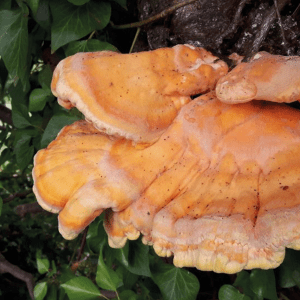
Hen of the woods (grifola frondosa) has much smaller brackets that are divided into frills rather than big rounded brackets. It is typically a greyer shade and again, does not bruise black.
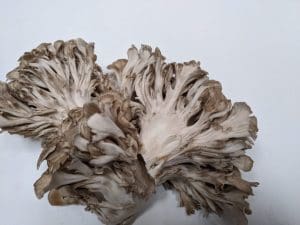
Both of these potential lookalikes are edible
Edible Use
The whole fruiting body is edible, mild-tasting, and has a firm fibrous texture a bit like chicken. It’s best when picked young and tender, as it can get tough as it matures. The black staining could look a little off-putting, but if you can get past that it works well as a vegan chicken substitute in curry, pies, casserole or stir fry
As with real chicken, make sure to cook it thoroughly to avoid stomach upsets.
Dried this mushroom can work well for making stocks
Notes on Herbal Use
None known. One paper has been published showing an extract from the fungus had some effect on a particular kind of cancer in mice, but as yet this hasn’t been developed into use for humans.
Extra notes from the Foragers
True to its name, this fungus can grow really impressively large clusters of fruiting bodies! they get quite tough and bitter tasting quickly as they mature, so it’s best to get it young. If you find a big one past its best though don’t despair, remember where you saw it and check again the next year.



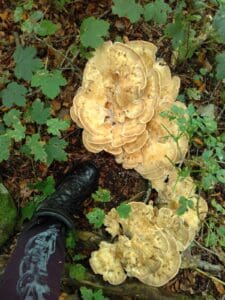
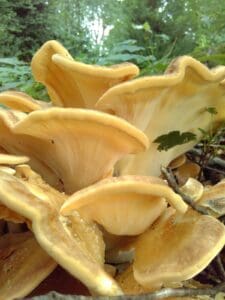
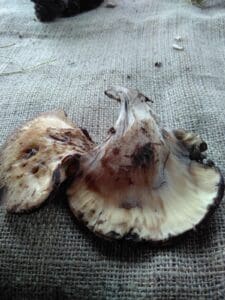
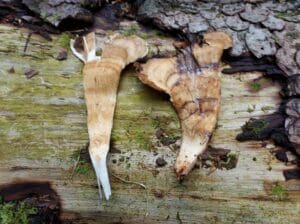
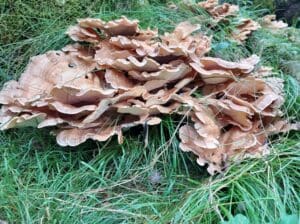
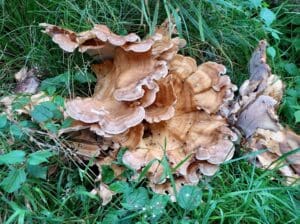
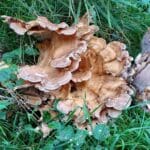
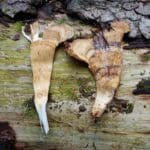
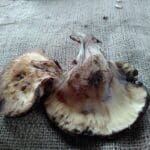



1 reply on “Giant Polypore Mushroom (Meripilus giganteus) Identification”